

Born to Learn: Class Reunion. Play Based Learning. 35 Psychological Tricks To Help You Learn Better. Have you ever considered letting your students listen to hardcore punk while they take their mid-term exam?

Decided to do away with Power Point presentations during your lectures? Urged your students to memorize more in order to remember more? If the answer is no, you may want to rethink your notions of psychology and its place in the learning environment. Below are 35 proven psychological phenomena that affect you and your students every day: 1. Definition: It is easiest to recall information when you are in a state similar to the one in which you initially learned the material. Application: Urge your students to sit in the same room they studied in when they complete their take-home quiz. 2. Definition: The tendency to overemphasize internal explanations for the behavior of others, while failing to take into account the power of the situation.
Application: Sometimes students need your help distinguishing between internal and external factors that affect academic performance. 3. 4. 5. 6. Blog — Teaching Kids to Learn: Curiosity in The... “I love learning, and when I get the opportunity to learn I’m stimulated and I’m happy…Curiosity is my prime mover, not an effect of something that happens to me.”
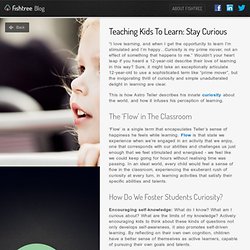
Wouldn’t your heart leap if you heard a 12-year-old describe their love of learning in this way? Sure, it might take an exceptionally articulate 12-year-old to use a sophisticated term like “prime mover”, but the invigorating thrill of curiosity and simple unadulterated delight in learning are clear. This is how Astro Teller describes his innate curiosity about the world, and how it infuses his perception of learning.
The ‘Flow’ in The Classroom.
Great Teachers Don't Teach. In a conversation on LinkedIn, one person asked, "What are the characteristics of an effective teacher?
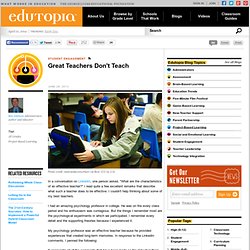
" I read quite a few excellent remarks that describe what such a teacher does to be effective. I couldn't help thinking about some of my best teachers. I had an amazing psychology professor in college. He was on fire every class period and his enthusiasm was contagious. But the things I remember most are the psychological experiments in which we participated. Gek van trainingen in organisaties☺? Doe de 70:20:10! The Impact of Music on Learning. Why is it that some prefer to study with classical music playing in the background while others soothing when working on difficult Math exercises ?
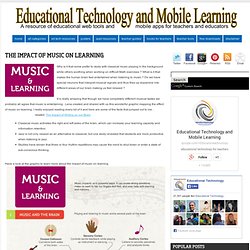
What is it that makes the human brain feel entertained when listening to music ? Do we have special neurons that interpret musical signals and thus fires up dopamine into different areas of our brain making us feel relaxed ? It is really amazing that though we have completely different musical tastes we probably all agree that music is entertaining . Lena created and shared with us this wonderful graphic mapping the effect of music on learning.
PrimaOnderwijs juni 2013 by EDG Media. 4 Different Visual Guides To Bloom's Taxonomy. I recently received a question from a reader who wasn’t clear about what exactly Bloom’s taxonomy is.
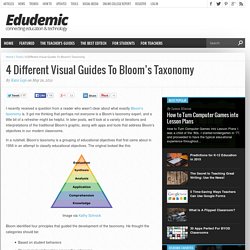
It got me thinking that perhaps not everyone is a Bloom’s taxonomy expert, and a little bit of a refresher might be helpful. In later posts, we’ll look at a variety of iterations and interpretations of the traditional Bloom’s graphic, along with apps and tools that address Bloom’s objectives in our modern classrooms. In a nutshell, Bloom’s taxonomy is a grouping of educational objectives that first came about in 1956 in an attempt to classify educational objectives.
The original looked like this: Bloom identified four principles that guided the development of the taxonomy. Based on student behaviorsShow logical relationships among the categoriesReflect the best current understanding of psychological processesDescribe rather than impose value judgments. The 7 Most Powerful Ideas In Learning Available Right Now. Tomorrow’s Learning Today: 7 Shifts To Create A Classroom Of The Future by Terry Heick For professional development around this idea or others you read about on TeachThought, contact us.
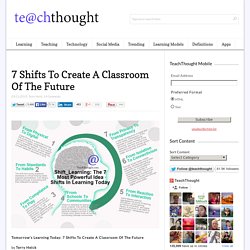
Let’s take a look at the nebulous idea of the “classroom of the future.” Born to Learn. That Look I’ve Most Certainly Seen Before. “The young cherish people and places from which they receive the skills and the emotional support which enable them to make it in the world or to meet their basic human needs” -James P.
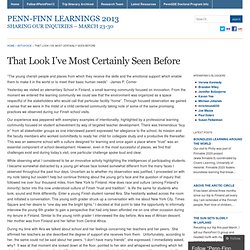
Comer Yesterday we visited an elementary School in Finland, a small learning community focused on innovation. From the moment we entered the learning community we could see that the environment was organized as a space respectful of the stakeholders who would call that particular facility “home”. Educational Technology and Mobile Learning: 14 Technology Concepts Every Teacher should Know about. We have compiled for you this list of some trending educational technology terms.The list below is a simple attempt to help you better capture the full picture of what all these tech terms are about by providing clear definitions to each one of them.

The sources of each definition is included in the last section of this post enjoy 1 - Adaptive Learning This is an educational method which uses computers as interactive teaching devices. Computers adapt the presentation of educational material according to students' learning needs, as indicated by their responses to questions and tasks. The motivation is to allow electronic education to incorporate the value of the interactivity afforded to a student by an actual human teacher or tutor. 2 - Virtual Classroom. Learners Should Be Developing Their Own Essential Questions. Having essential questions drive curriculum and learning has become core to many educators’ instructional practices.
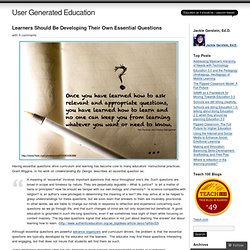
Grant Wiggins, in his work on Understanding By Design, describes an essential question as: A meaning of “essential” involves important questions that recur throughout one’s life. Such questions are broad in scope and timeless by nature. They are perpetually arguable – What is justice? Is art a matter of taste or principles? Although essential questions are powerful advance organizers and curriculum drivers, the problem is that the essential questions are typically developed by the educator not the learners. Ontwikkel je intelligentie - Robert Sternberg. Psychologie Magazine maakt gebruik van cookies.
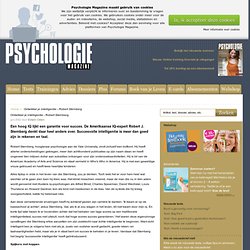
Why Learning Should Be Messy. The following is an excerpt of One Size Does Not Fit All: A Student’s Assessment of School, by 17-year-old Nikhil Goyal, a senior at Syosset High School in Woodbury, New York. Can creativity be taught? Absolutely. The real question is: “How do we teach it?” In school, instead of crossing subjects and classes, we teach them in a very rigid manner. Very rarely do you witness math and science teachers or English and history teachers collaborating with each other. “Today’s problems — from global poverty to climate change to the obesity epidemic — are more interconnected and intertwined than ever before and they can’t possibly be solved in the academic or research ‘silos’ of the twentieth century,” writes Frank Moss, the former head of the M.I.T. Schools cannot just simply add a “creativity hour” and call it a day. After indicating the problem at hand, scoop out the tools, research, networks, and people required to get it solved.
The first phase of the arc is called exploration. Related. 7 Essential Principles of Innovative Learning. Big Ideas Culture Teaching Strategies Flirck:WoodleyWonderworks Every educator wants to create an environment that will foster students’ love of learning. Because the criteria are intangible, it’s difficult to define or pinpoint exactly what they are. But one group is giving it a try. Researchers at the Organization for Economic Cooperation and Development (OECD) launched the Innovative Learning Environments project to turn an academic lens on the project of identifying concrete traits that mark innovative learning environments. Their book, The Nature of Learning: Using Research to Inspire Practice and the accompanying practitioner’s guide, lay out the key principles for designing learning environments that will help students build skills useful in a world where jobs are increasingly information and knowledge-based.
“Adaptive expertise tries to push beyond the idea of mastery,” said Jennifer Groff, an educational engineer and co-founder of the Center for Curriculum Redesign. Related. Calling all elearning infographics! – here’s 10 to start with. Infographics have become ubiquitous and they’re a brilliant way to get clear, useful overviews of what’s happening where! Here I’d like to propose a collection of samples relevant to elearning and learning technologies.
For a closer look at some of our favorite free tools for creating infographics check this post. We also like this article on how infographics can help you produce better elearning courses.
Leertheorieën. Mindset. Informeel leren. Bloom's taxonomy. Blended Learning. E-learning. M-learning. Peer learning. Feedback. Leerbericht2013. Nieuwspagina. Deze tijd vraagt om een nieuwe leeromgeving voor leerlingen én hun leraren, waarin het leren voor een loopbaan in een veranderende wereld minstens zo belangrijk is als kennisoverdracht. Dat vindt prof. dr. Marinka Kuijpers, die op 30 november 2012 haar oratie houdt als bijzonder hoogleraar bij LOOK, Wetenschappelijk Centrum Leraren Onderzoek van de Open Universiteit. Gezamenlijk reflecteren met behulp van video bij docentprofessionalisering. Reflecteren is een belangrijke leeractiviteit. Zelfreflectie heeft echter beperkingen. Inspirerende werkvormen - Goesting in Leren en Werken. Een les draait in essentie om de kennis en de vaardigheden die je wilt overdragen en delen. Om jongeren hier maximaal bij te betrekken, is het raadzaam om de didactische werkvorm hierop af te stemmen. Om met andere woorden te opteren voor een werkvorm die aanzet tot interactie en die de studenten inspireert tot leren zodat zij: actief deelnemen aan de les, zodat zij alert blijven;eigen input leveren, zodat de stof kan aansluiten bij hun voorkennis;verschillende leerstijlen afwisselen en combineren;meer succesvolle resultaten kunnen behalen;onderling en met de docent intensief contact opbouwen;met de lesstof bezig blijven en zich hierin verder verdiepen.
Studenten leren het meest op het moment dat ze actief met de leerstof omgaan en zelf moeten nadenken. Met activerende werkvormen kun je als docent aansluiten bij de verschillende leerstijlen.